Resource information
Conventional livestock farming provides consumers with cheap and reliable sources of milk and meat. Yet the inevitable by-product, i.e. livestock faecal matter, represents a potential source of pathogenic microorganisms. This paper applies the Faecal Indicator Organisms Costing Assessment Tool (FIOCAT), which was designed as part of the RELU project ‘sustainable and holistic food chains for recycling livestock waste to land’, to examine the costs associated with mitigation methods that may inhibit pathogenic transfers to water. FIO-CAT is comprised of three interrelated models: the economic dairy management (EDM) model, the farm business survey (FBS) model and the manure, infrastructure and environment (MIE) model. Specifically, it models dairy, and cattle and sheep farms in the River Taw catchment in South West England and determines the economic impact that mitigation methods have on farm businesses. However, the inherent complexity associated with heterogeneous landscapes confounds the likelihood that a single management strategy will provide complete protection of receiving waters from microbial contamination.


